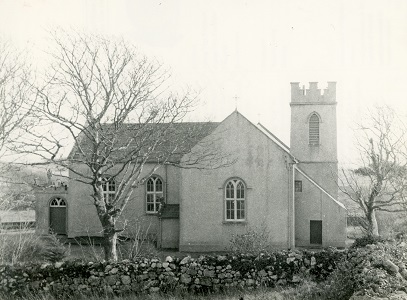Old Galway
THE CHURCH OF ST. JAMES, BARNA

by Tom Kenny
The first church in the Barna area that we know of was a small stone building with a thatched roof on the right of the road down to Silver Strand, just opposite the entrance to Tobar Éanna. You can still see some of the remains there. It was in use until December 1839. On June 4th, 200 adults were confirmed by Bishop Browne there.
The church in our photograph was named after St. James and was built in 1830’s on the main Barna Road. The first Mass there was celebrated on January 5th, 1840. It was a T-shaped structure, rather than cruciform, with a small sacristy attached to the top of the T. It was easier to construct and the Sacristy was placed behind the Sanctuary. It was typical of churches built after the Catholic Emancipation and it was paid for and built by the local Landlords, the Lynch family from Barna House. There was a gallery level in the east end of the nave which was reached by a timber stairs. This and the entrance porch and floor were additions to the original basic church. In a number of similar churches there was a room either over or under the Sacristy where the priest actually lived.
The Church of St James, Barna
The first church in the Barna area that we know of was a small stone building with a thatched roof on the right of the road down to Silver Strand, just opposite the entrance to Tobar Éanna. You can still see some of the remains there. It was in use until December 1839. On June 4th, 200 adults were confirmed by Bishop Browne there.
The Galway Gas Company

The Galway Board of the Town Commissioners was established in the early 1830’s and one of their first objectives was the provision of gas lighting in the city. In December 1836, they invited a Mr. Lyddle from Glasgow to do a survey of the town and he recommended the establishment of a Galway Gas Company. His advice was taken. Shares were snapped up, an agreement was reached between the company & the Town Commission and the Rev. D’Arcy was appointed company secretary.
Hardiman's Description of the Claddagh

“The only occupation is fishing; they never trouble themselves with tillage; a milch cow and a potatoe garden are rare among them ------, then on shore they are principally employed in attending to, and repairing their boats, sails, rigging, cordage etc .., and in making, drying or repairing their nets and spillets, in which latter employment they are generally assisted by the women who spin hemp and yarn for the nets...
175 Years of 'Mercy' Education in Galway

The Sisters of Mercy came to Galway on May 1st, 1840. They started, in extremely difficult circumstances, in Lombard Street with 3 postulants. The need for uncloistered sisters who would be free to go about the streets and visit the poor in home, hospital and jail was very great at the time. They were out and about the day after their arrival. An epidemic of cholera had broken out and they helped to nurse the ill and alleviate distress. They quickly prospered to become “Reputedly the best institution that ever was in Galway”.
The Lazy Wall

This photograph was taken looking west from where Seapoint is today. The house in the picture was roughly across the street from the Bon Bon. It was once an RIC barracks and was latterly occupied by Monica Wallace. There was a concrete bench along the wall in front of the house which was known as “The Lazy Wall”, a place where old and countrified people, known as “The Fámairí” , would relax and chat and gossip. They came not for the views but for the conversations. Many arrived after their crops had been harvested. They usually brought their own food in the form of home-cured bacon, fresh eggs, butter, cooked chickens and cakes of bread.”You rented a room and you ate yourself”. They would use the family kitchen of the house in which they were staying and consider themselves part of that family for the duration. There was a small bit of beach below the wall where the patrons could bathe or paddle.
Galvia / Calvary Hospital

An interesting number of medical institutions were established in Galway in the 20th century. In 1908, the Port Sanitary Intercepting Hospital was built near the docks opposite Forthill Cemetery as quarantine for any suspected cases of cholera or smallpox that might have come in on board ship. It cost £1,000, had 20 beds and happily it was never needed for its primary purpose and only ever housed 3 patients. It burnt down in 1966.
Máirtín Mór

This photograph of the corner of New Dock Street and Flood Street dates from the 1930s. The large threestorey house on Flood Street was formerly known as ‘The Dispensary’ and was the property of the Poor Law Guardians. It was obviously occupied by a doctor. It was in this house that the McDonogh dynasty began in Galway.
.png)
